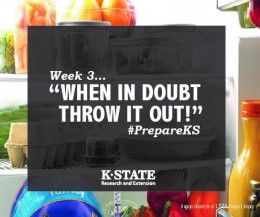September is National Preparedness Month. It is also our annual Prepare Kansas online challenge. Prepare Kansas 2017 will provide tips on getting financially prepared ahead of disasters and emergencies. This year’s program will be conducted through the K-State Research and Extension Facebook page. No registration is required, so Kansans and anyone interested in planning ahead for emergencies can follow on Facebook and this blog at any time during September, pick up handy information and interact with K-State extension specialists and agents. Today’s post is written by Elizabeth Kiss, Family Resource Management Specialist.
Disasters don’t plan ahead. You can. Prepare Kansas this year will help you take steps to be more financially prepared to weather any challenges, plus it’s a good way to stay organized.
You don’t know where to get back to if you don’t know where you started, right? This week’s challenge takes you step by step through preparing a household inventory. Why does this matter?
Emergencies and disasters may result in insurance claims. Your insurance company will likely require a listing of items lost or destroyed in order to document the claim. A household inventory is an itemized list of the contents of your home, including basement, attic, and garage. If you have sheds or storage areas on your property or if you rent a storage unit somewhere else, be sure to include a list of the contents of those too.
 While it is true that there is an initial investment of time and effort in preparing the inventory from scratch, once completed it will be useful into the future with regular updating. Your challenge this week is to prepare, or update, a household inventory, include storage areas. Here are some tips to get started:
While it is true that there is an initial investment of time and effort in preparing the inventory from scratch, once completed it will be useful into the future with regular updating. Your challenge this week is to prepare, or update, a household inventory, include storage areas. Here are some tips to get started:
- Household inventories can take many forms. Use the format that best suits your needs. Don’t get hung up on being perfect, if you are starting from scratch focus on the big ticket and hard to replace items.
- When describing furnishing and equipment, be as specific and accurate as possible.
- Include the original cost, date purchased, any alternations or repairs done on the item, and corresponding cost.
- Photograph or videotape every wall in each room of your home and storage areas.
- Include open closets, cabinets, cupboards, and drawers.
- Take close-ups of unique or expensive items to document their condition
- Date photographs; when videotaping verbally describe the contents as you move around the room
- Don’t forget to include personal items that might not always be stored at home and items that are in your vehicles.
- Save copies in more than format and more than one place. For example, keep a paper copy and store copies of the document, video inventory and pictures to a flash drive and the cloud.
Here are links to two examples of household inventory forms.
Personal Home Inventory (Kansas Insurance Department) http://www.ksinsurance.org/documents/department/publications/personal-home-inventory.pdf
Household Inventory (eXtension.org Financial Security for All) http://articles.extension.org/pages/11274/household-inventory
Want to learn more? Download this fact sheet from the K-State Research and Extension bookstore https://www.bookstore.ksre.k-state.edu/pubs/MF3055.pdf
 Not sure how to get started? This video from Jamie Rathbun, K-State Research and Extension Midway District family and consumers agent walks you through the process step-by-step with lots of helpful information.
Not sure how to get started? This video from Jamie Rathbun, K-State Research and Extension Midway District family and consumers agent walks you through the process step-by-step with lots of helpful information.




